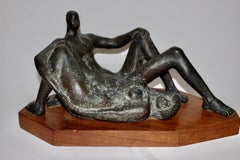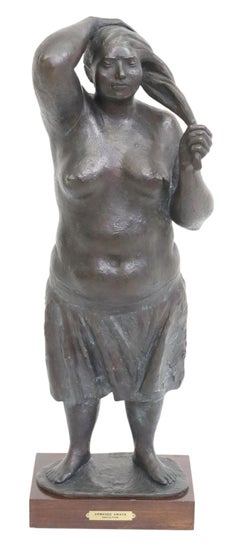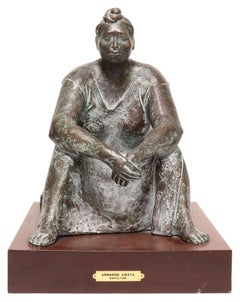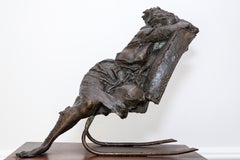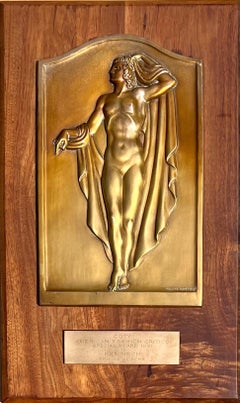Armando Amaya Art
to
3
2
1
Overall Height
to
Overall Width
to
3
3
3
2
2
2
1
1
3
1
2
3
6,996
3,348
2,513
1,213
3
3
3
Artist: Armando Amaya
Lovers Bronze Sculpture With Two Figures
By Armando Amaya
Located in Lake Worth Beach, FL
Lovers Bronze Sculpture With Two Figures
Modern Bronze sculpture on wooden base, signed, number 2/3
Sculptor Armando Amaya was born in Mexico City in 1935, He studied at the National...
Category
1960s Modern Armando Amaya Art
Materials
Bronze
Tehuana Standing Semi Nude Bronze Sculpture
By Armando Amaya
Located in Lake Worth Beach, FL
Tehuana Semi Nude
Bronze sculpture, signed and dated 1986, edition 2/7, wood base.
Sculptor Armando Amaya was born in Mexico City in 1935, He studied at the National School of Painting and Sculpture under Jose Ruiz...
Category
1980s Modern Armando Amaya Art
Materials
Bronze
Martha On The Bench Bronze Sculpture
By Armando Amaya
Located in Lake Worth Beach, FL
Martha de Tehuana en un Banco (Martha On The Bench)
Bronze sculpture, signed, original gallery label edition 1/11
Sculptor Armando Amaya was born in Mexico City in 1935, He studied at the National School of Painting and Sculpture under Jose Ruiz...
Category
1980s Modern Armando Amaya Art
Materials
Bronze
Related Items
Figure of a Woman Sleeping in a Rocking Chair by Bruno Lucchesi
By Bruno Lucchesi
Located in Brookville, NY
This bronze sculpture of a woman in a chair, is typical of the work of Bruno Lucchese. Born in Italy in 1926, Bruno Lucchesi has been referred to as “the last of the Renaissance scu...
Category
1960s American Modern Armando Amaya Art
Materials
Bronze
H 18 in W 9 in D 16 in
1961 Coty Award Plaque Kenneth Hairdresser Jacqueline Onassis Bronze Fashion
Located in New York, NY
1961 Coty Award Plaque Kenneth Hairdresser Jacqueline Onassis Bronze Fashion
Bronze on wood. The wood plaque measures 12 3/4" by 20 3/4 inches. The bronze plaque itself is 13 3/4 x 8 3/4 inches and the the bronze inscription, which reads "COTY, American Fashion Critics Special Award 1961 to KENNETH of LILY DACHE...
Category
1960s American Modern Armando Amaya Art
Materials
Bronze
After Alberto Giacometti, Man Standing Up, Bronze Figure
By Alberto Giacometti
Located in Pasadena, CA
Modern bronze with gold patina figural sculpture, in the style of Alberto Giacometti (Swiss, 1901-1966), not signed, depicting abstract nude male a figures, in a parcel gilt finish, ...
Category
1950s Modern Armando Amaya Art
Materials
Bronze
Mexican Art Abstract Brutalist Biomorphic Bronze Sculpture Mathias Goeritz
By Mathias Goeritz
Located in Surfside, FL
Mathias Goeritz (German Mexican, 1915-1990)
Bronze sculpture
Signed and numbered
Dimensions: (approximate) Height: 10 inches, Width: 4 inches, Depth: 2 inches.
This is a cast bronze sculpture in an amorphous figure shape, quite heavy. Reminiscent of the biomorphic sculpture of Hans Jean Arp. This came from an estate and bears his signature It is not dated. there is no accompanying documentation. it is priced accordingly.
Werner Mathias Goeritz Brunner (Danzig, Germany, April 4th, 1915/ now Gdansk, Poland – Mexico City, Mexico; August 4th, 1990).
Mathias Goeritz has had several gallery and museum exhibitions, including at the Museo Nacional Centro de Arte Reina Sofía and at the Museo Experimental El Eco. Numerous works by the artist have been sold at auction, including 'MENSAJE' sold at Sotheby's New York 'Latin American Modern Art' in 2015 for $466,000. There have been Several articles about Mathias Goeritz, including 'LACMA remaps Latin America' written by Suzanne Muchnic for the Los Angeles Times.
Painter, sculptor and Mexican architect associated with the trend of constructive abstraction. He studied medicine at the University of Berlin, but this only lasted a year. The concerns of the young student were aesthetic in nature so he he studied figurative drawing at the Berlin Charlottenburg School of Art. Some of his friends and colleagues were the sculptor Ernst Barlach, painter George Grosz and draughtsman Kaethe Kollwitz. Goeritz studied philosophy and history of art, discipline in which earned a doctorate. He travelled in France, Switzerland, Czechoslovakia, Poland, Austria and Italy, among other countries.
It is known that he left Germany to live in Tetuan, Morocco in 1941 and then Granada, Spain in 1945. In 1946 he had a large exhibition in the Sala Clan in Madrid under the pseudonym "Mago". Two years later, living in Santilla del Mar, Spain he was a founder of the Escuela de Altamira. The following year he married Marianne Gast, writer and his companion for more than fifteen years. In Spain followed his artistic work by important artists of the avant-garde.
Of Jewish descent, he found refuge from the Second World War in Mexico where in 1949 he was invited by Ignacio Diaz Morales to be a part of the faculty of the School of Architecture at the Universidad de Jalisco. In 1953 he wrote the "Manifiesto de la Arquitectura Emocional" (The Emotional Architecture Manifesto), where he points out that only achieving true emotions from architecture can it then be considered an art form. In Mexico he entered controversy with the artistic stablishment of that country; in an open letter, Diego Rivera and David Alfaro Siqueiros described him as "an impostor without the most insignificant talent and preparation" to be an artist. Despite this, in 1957 he was elected director of visual design of the National School of architecture This same year he founded the Museo del Eco in Mexico City. In 1961 Goeritz participated at the Galería Antonio Souza in a group exhibition, Los hartos, for which he published another manifesto. Other participants included Jose Luis Cuevas and Pedro Friedeberg, with whom he was instrumental in establishing abstraction and other modern trends in Mexico.His work is included in the Gelman Collection of modern and contemporary Mexican art based in Cuernavaca, Mexico. Established by Jacques and Natasha Gelman in 1943 as a private collection. it includes many iconic works by major Mexican Modernists including Frida Kahlo, Diego Rivera, David Alfaro Siqueiros, Leonora Carrington, Rufino Tamayo and Francisco Toledo, Lola Alvarez...
Category
20th Century Modern Armando Amaya Art
Materials
Bronze
Modern Bronze Figure
Located in New York, NY
Bronze sculpture by Betty Jacob depicts a smooth and curvaceous gilt bronze figure posing on her knees.
Signed high on the left thigh and mounted on a blac...
Category
1970s American Modern Armando Amaya Art
Materials
Bronze
Bronze Flower Sculpture Plaque
By Ruth Asawa
Located in New York, NY
Ruth Asawa
Bronze Flower, 1979
Cast Bronze relief plaque with original presentation box
5 1/4 × 6 1/4 × 1/4 inches
Numbered from the Edition of 2500
Signed and dated 'Asawa 1979' (lower edge) incised in the bronze; numbered; stamped "Designed Exclusively for Crown Zellerbach Corporation"; foundry copyright
Cast at the Berkley Arts Foundry for Crown Zellerbach
Ruth Asawa's estate is represented by David Zwirner.
Unframed
This beautiful, limited edition signed cast bronze flower plaque makes a distinctive and original gift! It bears the artist's incised signature and is uniquely numbered from the limited edition of 2500. In 1979, the Crown Zellerbach Corporation of San Francisco, which had worked closely with her on neighborhood arts programs, commissioned Asawa to make a series of bronze bas-relief plaques, including this beautiful piece, which were cast by the Berkeley Arts Foundry.
Cast at Berkley Arts Foundry for Crown Zellerbach
Another example of this work was exhibited in the show "On Black Mountain: The Bauhaus Legacy in America", April 5, 2019-April 27, 2019 at the Sager Braudis Gallery in Columbia, Missouri. It is reproduced on page 13 of the exhibition catalogue.
Ruth Asawa Biography
American artist, educator, and arts activist Ruth Asawa (1926-2013) is known for her extensive body of wire sculptures that challenge conventional notions of material and form through their emphasis on lightness and transparency. Born in rural California, Asawa was first exposed to professional artists while her family and other Japanese Americans were detained at Santa Anita, California, in 1942. Following her release from an internment camp in Rohwer, Arkansas, eighteen months later, she enrolled in 1943 in Milwaukee State Teachers College. Unable to receive her degree due to continued hostility against Japanese Americans, Asawa left Milwaukee in 1946 to study at Black Mountain College in North Carolina, then known for its progressive pedagogical methods and avant-garde aesthetic environment. Asawa's time at Black Mountain proved formative in her development as an artist, and she was particularly influenced by her teachers Josef Albers, Buckminster Fuller, and the mathematician Max Dehn. She also met architectural student Albert Lanier, whom she would marry in 1949 and with whom she would raise a large family and build a career in San Francisco. Asawa continued to produce art steadily over the course of more than a half century, creating a cohesive body of sculptures and works on paper that, in their innovative use of material and form, deftly synthesizes a wide range of aesthetic preoccupations at the heart of postwar art in America.
Asawa’s work has been exhibited widely since the early 1950s, including early solo exhibitions at Peridot Gallery, New York in 1954, 1956, and 1958. In 1965, Walter Hopps organized a solo exhibition of the artist’s sculptures and drawings at the Pasadena Art Museum (now Norton Simon Museum) in California, where Asawa completed a residency at the Tamarind Lithography Workshop the same year. Other solo presentations include those held at the San Francisco Museum of Art (1973); Fresno Art Museum, California (2001; traveled to Oakland Museum of California, 2002); de Young Museum, San Francisco (2006); Amon Carter Museum of American Art, Fort Worth, Texas (2012); and Norton Simon Museum of Art, Pasadena, California (2014).
In 2018 to 2019, the Pulitzer Arts Foundation in St. Louis presented Ruth Asawa: Life’s Work, the first major museum exhibition of the artist’s work in more than a decade. An accompanying catalogue published by Pulitzer Arts Foundation and Yale University Press includes essays by Aruna D’Souza, Helen Molesworth, and Tamara H. Schenkenberg. The two-person exhibition, Lineage: Paul Klee and Ruth Asawa was on view at the San Francisco Museum of Modern Art in 2021. In 2022, Ruth Asawa: Citizen of the Universe was on view at Modern Art Oxford, England, and later traveled to the Stavanger Kunstmuseum, Norway. Opening September 16, 2023 at the Whitney Museum of American Art, New York is Ruth Asawa: Through Line, a solo presentation which will later travel to the Menil Drawing Institute in Houston.
The artist’s works have also been included in significant group exhibitions, including Leap Before You Look: Black Mountain College 1933–1957, Institute of Contemporary Art, Boston (2015; traveled to Hammer Museum, Los Angeles, and Wexner Center for the Arts, Columbus, Ohio, 2016-2017); America Is Hard to See, Whitney Museum of American Art, New York (2015); Revolution in the Making: Abstract Sculpture by Women, 1947–2016, Hauser & Wirth, Los Angeles (2017); Making Space: Women Artists and Postwar Abstraction, The Museum of Modern Art, New York (2017); The Pencil Is a Key: Drawings by Incarcerated Artists, The Drawing Center, New York (2019); and In a Cloud, in a Wall, in a Chair: Six Modernists in Mexico at Midcentury, Art Institute of Chicago (2019). A selection of the artist's work was presented at the 59th Venice Biennale, The Milk of Dreams (2022).
In addition to her wire sculptures, Asawa is well known for her public commissions, particularly in San Francisco and the wider Bay Area. These include the much beloved Andrea fountain in Ghirardelli Square (1966-1968) and the San Francisco Fountain outside the Grand Hyatt Union Square (1970-1973), the latter of which includes hundreds of baker’s clay images molded by local schoolchildren, friends, and other artists cast...
Category
Mid-20th Century Modern Armando Amaya Art
Materials
Bronze
Harmony, 20th century bronze & green marble base, nude man and woman with lyre
By Max Kalish
Located in Beachwood, OH
Max Kalish (American, 1891-1945)
Harmony, c. 1930
Bronze with green marble base
Incised signature on right upper side of base
14 x 9 x 5 inches, excluding base
17 x 10 x 8 inches, including base
Born in Poland March 1, 1891, figurative sculptor Max Kalish came to the United States in 1894, his family settling in Ohio. A talented youth, Kalish enrolled at the Cleveland Institute of Art as a fifteen-year-old, receiving a first-place award for modeling the figure during studies with Herman Matzen. Kalish went to New York City following graduation, studying with Isidore Konti...
Category
1930s American Modern Armando Amaya Art
Materials
Marble, Bronze
"Untitled" bronze sculpture of seated female figure by artist Felipe Castañeda
By Felipe Castañeda
Located in Boca Raton, FL
"Untitled" bronze sculpture of a female nude by artist Felipe Castañeda. Inscribed F. Castañeda 1984 P/A on base.
Category
1980s Modern Armando Amaya Art
Materials
Bronze
Diosa Original bronze multiple. Esculpture Modernist
Located in CORAL GABLES - MIAMI, FL
Diosa. Original bronze multiple. Esculpture Modernist
Julien Caussé (also given as Cadet-Julien Caussé, Cadet Julien Caussé and Julien Cadet Caussé) (1869–1914) was a prolific French...
Category
Early 1900s Modern Armando Amaya Art
Materials
Bronze
H 19.69 in W 5.91 in D 5.91 in
Woman Seated A Bronze Sculpture of a Woman by Charles Rumsey
By Charles Cary Rumsey
Located in Brookville, NY
The bronze sculpture of a woman by Charles Rumsey is undated, but was created at a point in his career where he began to transition from realism to more modern, looser depictions of ...
Category
1920s American Modern Armando Amaya Art
Materials
Bronze
H 10.5 in W 11 in D 6 in
Rève (assise)
Located in Villafranca Di Verona, IT
Numbered and limited to 12 copies ( 8 + 4 P.A)
Artwork signed
Authenticity: Sold with certificate of Authenticity from the gallery
Invoice from the gallery
Sculpture: bronze, metal,...
Category
21st Century and Contemporary Modern Armando Amaya Art
Materials
Bronze
Bronze Female Nude Sculpture Modernist, WPA, New York Chelsea Hotel Artist
By Eugenie Gershoy
Located in Surfside, FL
Eugenie Gershoy (January 1, 1901 – May 8, 1986) was an American sculptor and watercolorist. Eugenie Gershoy was born in Krivoy Rog, Russia (Krivoi Rog, Ukraine) and emigrated to New York City in the United States as a child in 1903. Considered somewhat of a child prodigy, Gershoy was copying Old Master drawings at the age of 5. Her interest and talent in art was encouraged from a very young age. Aided by scholarships, she studied at the Art Students League under Alexander Stirling Calder, Leo Lentelli, Kenneth Hayes Miller, and Boardman Robinson. Around this time, she created a group of portrait figurines of her fellow artists, including Arnold Blanch, Lucile Blanch, Raphael Soyer, William Zorach, Concetta Scaravaglione, and Emil Ganso, which were exhibited as a group at the Whitney Museum of American Art. At age 17, she was awarded the Saint-Gaudens Medal for fine draughtsmanship. Early in her career she became an active member of the Woodstock art colony. In Woodstock she experimented by sculpting in the profusion of indigenous materials that she found. Working with fieldstone, oak and chestnut, Gershoy created works based on classic formulae. As she became more interested in the dynamism of everyday life, she found that these materials and her idiom were too restrictive. By the time Gershoy came to Woodstock in 1921 her own individual artistic style was already evident in her sculptures. Eugenie Gershoy worked in stone, bronze, terracotta, plaster and papier-mache. Gershoy’s sculptures were mainly figurative in nature and many of her artist peers such as Carl Walters, Raphael and Moses Soyer, William Zorach and Lucille Blanch, became her subjects. Eugenie Gershoy’s works on paper should not be overlooked. She was the winner of the Gaudens Medal for Fine Draughtsmanship at the tender age of 17. Gershoy married Jewish Romanian-born artist Harry Gottlieb. In the late 1920s and early 1930s, the pair kept a studio in Woodstock, New York. There, Gershoy was influenced by sculptor John Flanagan, who lived and worked nearby.
From 1936 to 1939, Gershoy worked for the WPA Federal Art Project. She collaborated with Max Spivak on murals for the children's recreation room of the Queens Borough Public Library in Astoria, New York. She developed a mixture of wheat paste, plaster, and egg tempera, which she used in polychrome papier-mâché sculptures; she was the only New York sculptor to work in polychrome at this time. She also designed cement and mosaic sculptures of animals and figures to be placed in New York City playgrounds. Alongside others employed by the FAP, she participated in a sit-down strike in Washington, DC, to advocate for better pay and improved working conditions for the projects' artists.
Gershoy's first solo exhibition was held at the Robinson Gallery in New York in 1940. She moved to San Francisco in 1942, and began teaching ceramics at the California School of Fine Arts in 1946. In 1950, she studied at the artists' colony at Yaddo.
Gershoy traveled extensively throughout her life. She visited England and France in the early 1930s, and worked in Paris in 1951. She traveled to Mexico and Guatemala in the late 1940s, and also toured Africa, India, and the Orient in 1955.
In 1977, Gershoy dedicated a sculpture to Audrey McMahon, who was actively involved in the creation of the Federal Art Project and served as its regional director in New York, in recognition of the work McMahon provided struggling artists in the 1930s.
Gershoy's work is in the collections of the Whitney Museum of American Art, the Metropolitan Museum of Art, and the Smithsonian American Art Museum. Her papers are held at Syracuse University Grant Arnold introduced her to lithography in 1930 and Gershoy depicted many scenes of Woodstock artists and their daily activities through this medium. From 1942 to 1966 Gershoy lived and painted in San Francisco where she taught at the San Francisco Art Institute. She traveled extensively, filling sketchbooks with scenes of Mexico, France, Spain, Africa and India. During her later years Eugenie Gershoy returned to New York City and concentrated on numerous well received exhibitions. Her last exhibition in at Sid Deutsch Gallery included many of the sculptures that were later exhibited in the Fletcher Gallery.
John Russell, former chief critic of fine arts for the New York Times, writes about the 1986 Sid Deutsch exhibition:
“As Eugenie Gershoy won the Saint-Gaudens Medal for fine draftsmanship as long ago as 1914 and since 1967 has had 15 papier-mache portrait figures suspended from the ceiling of the lobby of the Hotel Chelsea, she must be ranked as a veteran of the New York scene. Her present exhibition includes not only the high-spirited papier-mache sculptures for which she is best known but a group of small portraits of artists, mostly dating from the 30’s, that is strongly evocative.”
Eugenie Gershoy is an artist to take note of for several reasons. She was a woman who received great awards and recognition during a time when most female artists were struggling to hold their own against their male counterparts. As a young girl she won a scholarship to the Arts Student League where she met Hannah Small...
Category
Mid-20th Century American Modern Armando Amaya Art
Materials
Bronze
Armando Amaya art for sale on 1stDibs.
Find a wide variety of authentic Armando Amaya art available for sale on 1stDibs. You can also browse by medium to find art by Armando Amaya in bronze, metal, wood and more. Much of the original work by this artist or collective was created during the 20th century and is mostly associated with the modern style. Not every interior allows for large Armando Amaya art, so small editions measuring 9 inches across are available. Customers who are interested in this artist might also find the work of Walter Bastianetto, Michael Ayrton, and Robert Kulicke. Armando Amaya art prices can differ depending upon medium, time period and other attributes. On 1stDibs, the price for these items starts at $3,000 and tops out at $6,500, while the average work can sell for $6,000.
